Grecotel Filoxenia Kalamata: The Rebirth of a Hospitality...
A historic hotel redefines modern Greek...
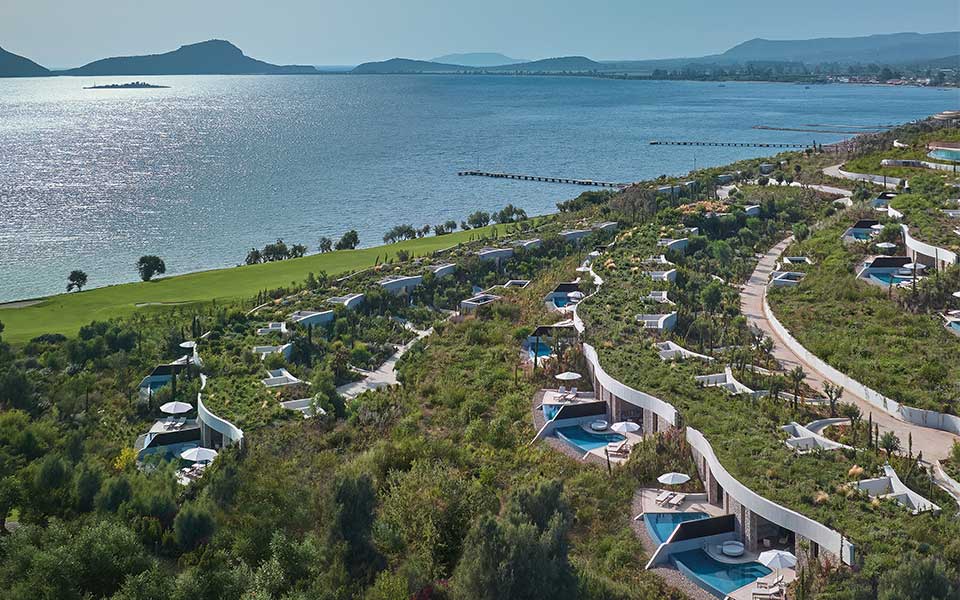
A view of Mandarin Oriental, Costa Navarino from above, with its earth-sheltered suites and terraced villas, all “hidden” under planted roofs and offering stunning Navarino Bay views.
© George Apostolidis
There are hotel brands whose properties are considered destinations in their own right. Just as we say “I’ve been there” for a particular country or city that has been etched in our mind, we also say “I’ve stayed there” for certain hotels. I’m referring to those places that transcend their designation as “luxury” hotels to achieve – and continuously redefine – perfection in the area of hospitality. Those that offer a life experience and whose presence in a particular destination raises the status of the location across the international tourism sector in general and in the eyes of that sector’s most demanding and affluent guests in particular. I’m referring, of course, to that class of traveler that the 20th-century journalist Igor Cassini dubbed “the jet set”.
It’s not of paramount importance how such hotel brands price their services, because their core customers know the true value of the services they offer. They know, too, that these hotel brands will always lead the way when it comes to innovation, sustainability, best practices, aesthetics, gastronomy – in fact, in everything. After all, if these great names can’t live up to the expectations they have created through years of dedicated effort and investment, they run the risk of jeopardizing their reputation.
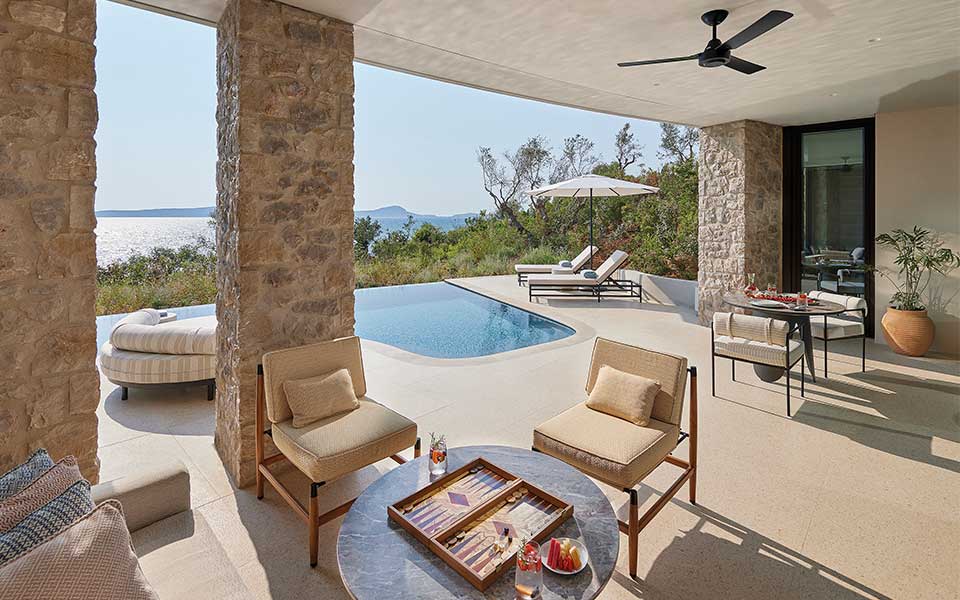
Views of villas that allow guests to transition seamlessly from indoors to outdoors.
© George Apostolidis
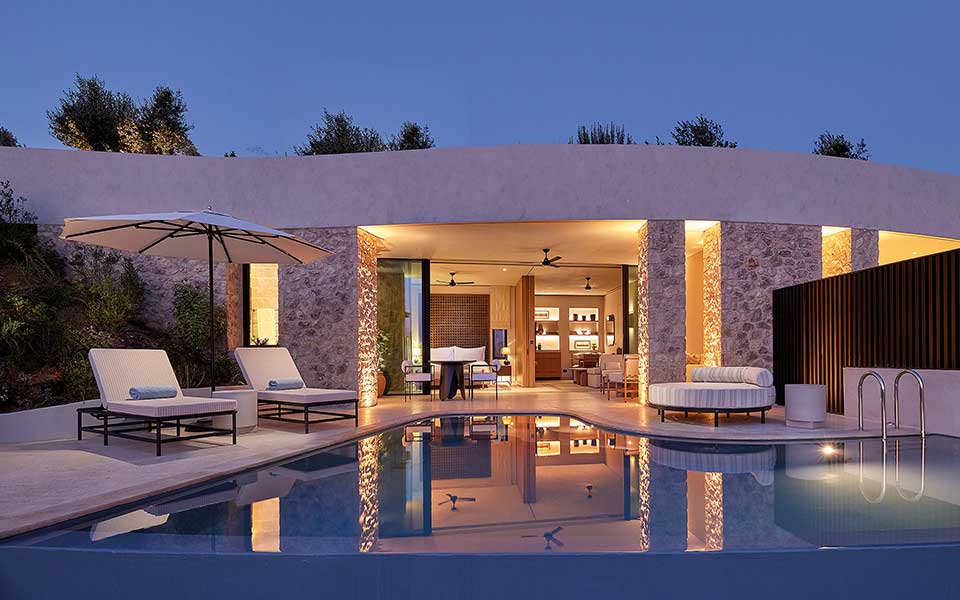
© George Apostolidis
Countless lists of hotel brands of this caliber are published every year. A recent survey of the best luxury hotel brands, published by CEOWORLD magazine in April 2023, include, among other hotel brands, Six Senses, Soneva, Rosewood, Four Seasons, One & Only, Aman and, of course, Mandarin Oriental, whose hotels have prominently figured on these lists for years.
I’ve never stayed at any of the Mandarin Oriental hotels, but I’m familiar with the brand’s iconic fan logo, as well as its award-winning advertising campaign, launched in 2000, which showcases an impressive cast of international celebrities who regularly stay at its hotels (Christoph Walz, Cecilia Bartoli, Helen Mirren, Liam Neeson, Michelle Yeoh, Morgan Freeman, Isabelle Huppert and others). It should be noted that while many luxury hotel brands recruit notable individuals for their campaigns, Mandarin Oriental goes one step further, rewarding its celebrity guests (who are, in fact, true fans of its hotels) with a donation to the charity of their choice.
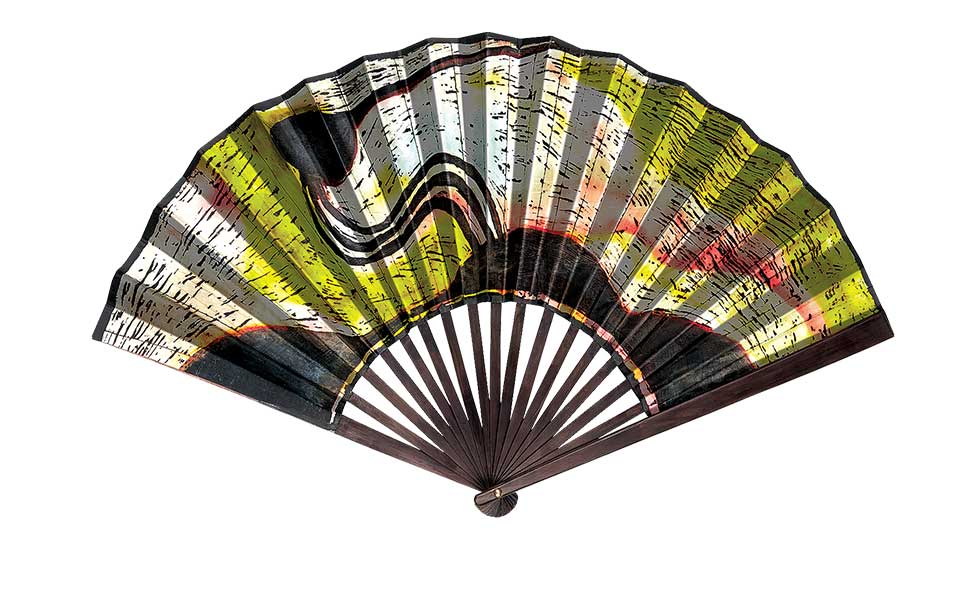
The resort’s fan log, designed by Dimitris Papaioannou
The first Mandarin Oriental hotel opened its doors 60 years ago in Hong Kong. In 1974, a second hotel opened in Bangkok, laying the foundation for a hospitality group that gradually expanded throughout the world. Today, the Mandarin Oriental Hotel Group operates 38 hotels worldwide (more locations are currently under development), all renowned for their luxury. In fact, Forbes magazine has awarded 25 of the Group’s hotels five-star status in recognition of the experience they offer their guests.
Mandarin Oriental is a luxury hotel brand that combines traditional Asian hospitality with modern cosmopolitanism. The following extract – from an article on the Mandarin Oriental, Bangkok by freelance travel writer Lee Cobaj which appeared in the luxury and lifestyle travel magazine Condé Nast Traveler as part of a review of the best hotels and resorts in the world – gives you a good idea of what this blend produces: “On my last visit to the Mandarin Oriental, Bangkok, I ended up chatting to a family of Thai tuna-fish billionaires over plates of sushi at kaiseki restaurant Kinu by Takagi. A few months before, I gave Russell Crowe a big smile and a nod in the corridor, thinking his face looked familiar – an old neighbor? Then there was the time I was upgraded to the glorious ivory-and-jade-green John le Carré suite and spent most of my time in a bathrobe watching long-tails, tankers, and rice barges zigzagging along the Chao Phraya River, imagining myself to be a real writer.”
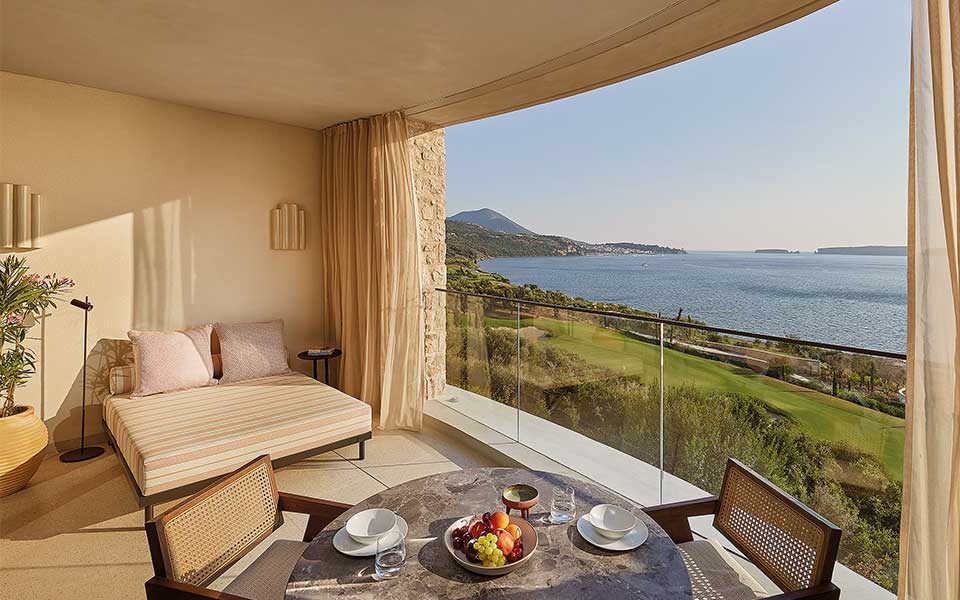
Guests will be able to move from indoor areas to outdoor spaces with great ease.
© George Apostolidis
Although its origins lie in the Far East, the Mandarin Oriental Hotel Group has always managed to integrate, with respect and a touch of imagination, the local culture of each destination into its hotels. For example, every hotel has its own fan logo, designed by local artists and inspired by the region’s local history and cultural heritage.
The logo of Mandarin Oriental, Paris, for example, was designed by Maison Lesage, an haute-couture embroidery atelier that is part of Chanel’s Métiers d’art, while in Dubai, the hotel’s fan logo was designed by Aljoud Lootah, a multidisciplinary designer based there.
The renowned Chinese fashion designer Vivienne Tam designed the logo for Mandarin Oriental, Guangzhou, while Dimitris Papaioannou – perhaps Greece’s most multitalented and internationally renowned artist – was commissioned to design the fan logo of Mandarin Oriental, Costa Navarino. For his work, Papaioannou drew inspiration from ancient Mycenaean motifs and the colors of the Messenian landscape.
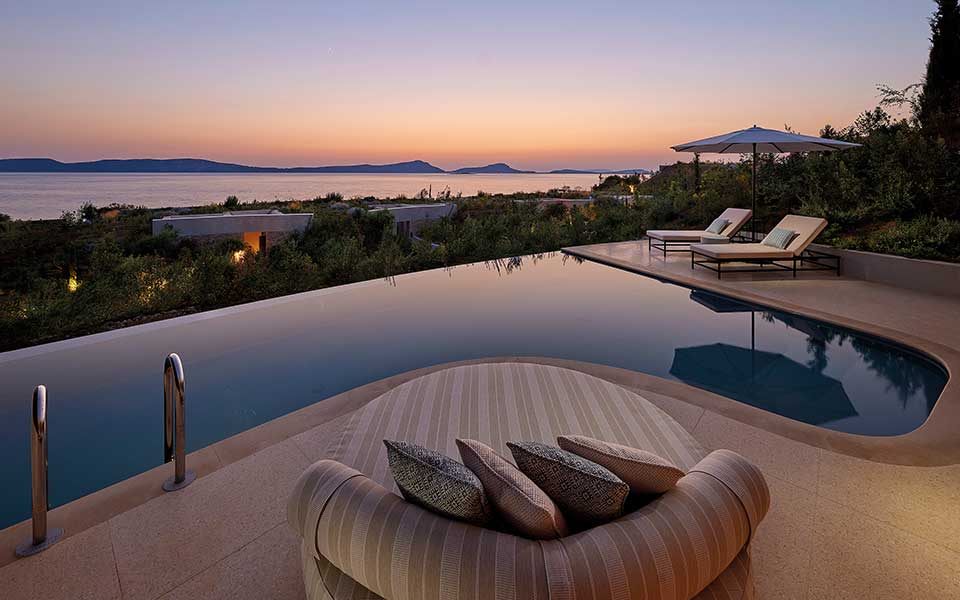
© George Apostolidis
Mandarin Oriental, Costa Navarino officially opened its doors. The areas and spaces that you see on these pages came alive, welcoming their first guests. And what a welcome awaits them! The influence of the Messinian countryside did not stop at the unique fan logo. The terraced design of the hotel’s earth-sheltered villas, discreetly nestled into the hillside, offers unobstructed, panoramic views of the Navarino Bay, bringing guests as close as possible to nature and the area’s unspoiled beauty. The hotel’s architectural features are inspired by local rural traditions and the stone sheepfolds that dot the region. Built from local stone, the hotel’s villas and suites follow the landscape’s natural contours, creating the feeling that the resort is organically linked to its location, incorporating as it does such natural elements as trees or large rocks. The hotel was designed and built on the principles of green architecture; the villas’ planted roofs blend in so perfectly with the natural landscape that, from above, the resort is almost invisible.
Another characteristic aspect of Mandarin Oriental, Costa Navarino is the seamless flow between the hotel’s indoor and outdoor areas, enabling guests to interact with nature effortlessly. This indoor/outdoor connection, along with the use of local materials, is prominent throughout the resort. Interior stone walls are covered with a natural coating, while exterior concrete components have been left unashamedly exposed – although they have been polished – to offer a minimalist contrast. Windows with innovative aluminum frames offer unobstructed views of the sea. Olive trees, cypress trees, lavender shrubs and thyme plants envelop the building, toning down those concrete exteriors and giving the structure a sense of true rootedness.
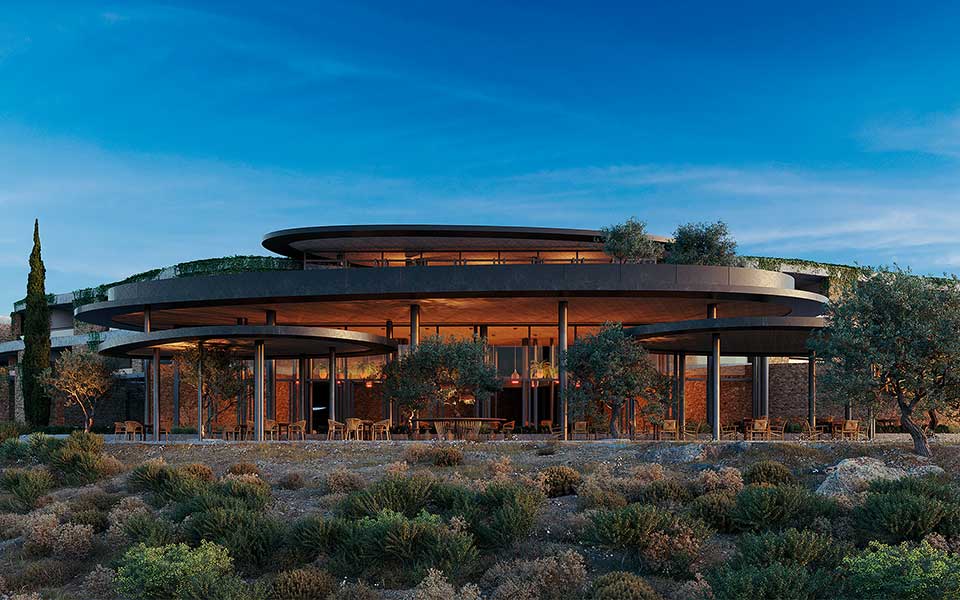
A digital representation of the Oliviera restaurant.
© George Apostolidis
The hotel’s interior design reflects, in both the materials and shapes that were chosen, the beauty of; nature itself. It’s characterized by touches of finesse and elegance, incorporating elements inspired by travels around the world. The design is complemented by a palette of earthy undertones with subtle motifs and soothing colors. Design aficionados will also be able to make out references to ancient Greek handicrafts, to the region’s historical landmarks, and even to the Greek revolution of 1821, with motifs, fretwork and traditional costumes on view.
The Mandarin Oriental, Costa Navarino, the fourth hotel developed by TEMES S.A., a leading destination developer, stretches out over an area of 140 hectares with views of Navarino Bay. It has 99 rooms, including 48 earth-sheltered villas with a private pool, as well as five restaurants and bars and an impressive spa that will open in the fall. Tombazis & Associates Architects and K-Studio developed the resort’s design, while the indoor areas and spaces were designed by Alexander Waterworth, Studio Afroditi Krassa, MKV Design and K-Studio.
NB: In a recent interview given to the journalist Ilias Bello of “Kathimerini” newspaper, the Group Chief Executive of Mandarin Oriental Hotel Group James Riley expressed his confidence that a third Mandarin Oriental – in addition to Mandarin Oriental, Costa Navarino and the one currently under construction in collaboration with TEMES S.A. and anticipated to open in 2027 in Elliniko, Athens – will be constructed in Greece in the near future.

A digital representation of the spa (which will open its doors in the fall).
© George Apostolidis
Contributing to local communities and protecting the environment are two of the main pillars on which the Group’s development strategy is founded. Its goals include transforming its hotels into plastic-free facilities and expanding its procurement programs to cover the key categories of seafood, coffee, tea, vanilla, cocoa and eggs, all sourced responsibly. On the basis of the principles of green architecture, Mandarin Oriental, Costa Navarino was designed with an emphasis on maximizing energy efficiency and respecting the natural environment.
The earth-sheltered villas offer many climate and energy benefits. The resort’s facilities use electricity for which guarantees of origin will be received.
The resort has been set up so that its scale of operations can contract or expand to meet capacity needs, depending on the level of occupancy, thus reducing energy consumption and improving the guests’ experience.
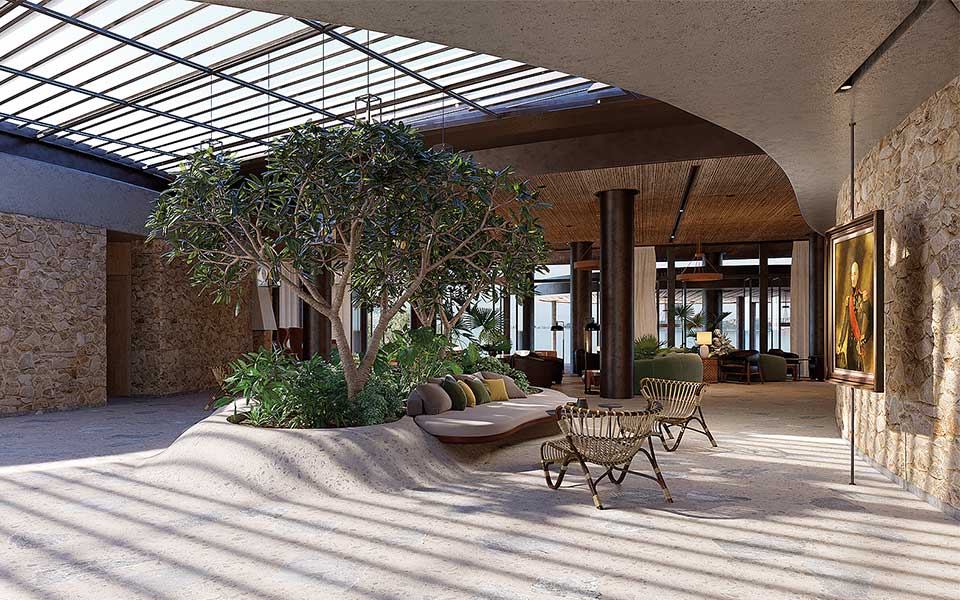
A digital representation of the lobby.
© George Apostolidis
The shade that is provided by the resort’s façade and the natural ventilation in the open spaces makes the need for mechanical cooling support in these spaces unnecessary without, however, compromising guest comfort. The strategy of abolishing air conditioning systems, wherever possible, is being achieved with the creation of semi-protected areas that “filter” the weather conditions.
Materials such as marble, mosaic and stone, all of which have come from local suppliers, don’t require a lot of maintenance and “mature” over time to further blend in with the surrounding landscape.
The Navarino Bay area is now home to more than 2,700 replanted olive trees and 500,000 planted shrubs.
Recycling will be carried out throughout the resort via the creation of different waste streams based on circular economy principles aimed at achieving zero waste.
In the near future, a large part of the power that the resort uses will be produced on-site through renewable sources, a strategy consistent with the commitment that the hotel has made to achieve a net zero carbon footprint by 2030.
A historic hotel redefines modern Greek...
Opening June 15 on the sunlit...
Patmos Aktis, Resort & Spa combines...
The Olympic elite, Hollywood’s finest, the...